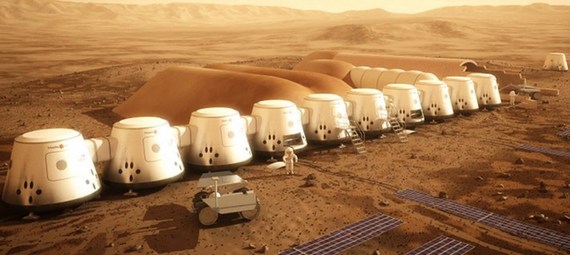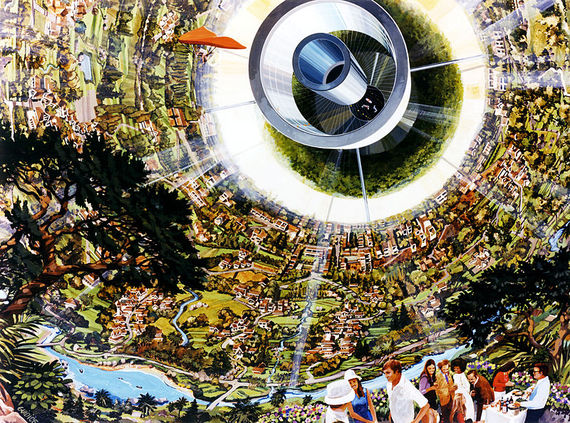
Wow!
The response to my previous blog post, "The Dismal Future of Interstellar Travel," has been impressive and incredibly interesting! It's amazing what can happen when you try to redirect people's enthusiasms and dreams into a slightly different direction.
Here is a recap of the situation:
I proposed that interstellar travel is so expensive, and benefits so few people among billions, that there is essentially no chance whatsoever that human society will ever attempt it, especially given the scientific limitations, human psychology and physiology, and conceivable technological breakthroughs. There is no human activity across 10,000 years of human history that provides the framework for undertaking this kind of monumental challenge in the next few centuries.
Here is what I recommended instead:
Channel all our creative energies into turning our entire solar system into a highly developed environment like Paris or New York, where we have extensive colonization of all the habitable surfaces on planets and their moons, or massive orbiting colonies spread across the Solar System, and travel times are measured in days, not years. Use virtual technology to involve all of humanity in a personal experience of planetary exploration, not just the few million off-worlders we could have in place by, say, 2500 A.D. There is no shame, embarrassment, or denial of dreams involved in turning our solar system into a Garden of Eden. We could also invest in nanotechnology to launch interstellar probes weighing only a few kilograms but capable of building, at the destination, thousand-ton laboratories for remote exploration and returning virtual-reality information back to the Solar System for all of us to enjoy, not just a few colonists. There has yet to be much science-fiction literature that thoroughly works out the possibilities of such a solar system-girding civilization.
You could probably replicate this Mars One concept 100 times across the Solar System for less than one interstellar voyage! (Credit: Mars One)
Well, the comments I got ranged from agreeing with my premise to accusing me of being a narrow-minded sod who should never have any contact with students or dreamers yearning for new high frontiers.
So let me try this again.
First of all, you have no idea how big the interstellar frontier is. Not even astronomers who study this 24/7/365 as part of their careers have a good gut instinct for the distances involved. So any technology we have today, or any extension of it that we can actually build, will not match the challenge of interstellar travel, especially at a price human society will care to pay. Humans pay for big projects that have intermediate goals that are also worthwhile. The railroad system or highway system could be used within a few months for limited but expanding service. There are no such intermediate goals for interstellar travel that have social benefit and can keep the momentum for funding going. It's all or nothing. Every technology the "dreamers" have invented has major drawbacks in implementation and human safety. Even unmanned probes are expensive and will vanish from human memory by the time they reach their destinations centuries hence!
And now let's talk about destinations!
Thanks to the last 20 years of planet searches, we have darn-good statistics on how many stars have planets, how many of these are in their habitable zones, and how many are Earth-sized.
NASA's Kepler mission monitored 157,000 stars and found about 3,900 with candidate planets. Of these about 647 were Earth-sized, and 10 were in their habitable zones. Kepler only detected planets if their orbits were "edge on" to Earth. But from simple statistical sampling principles, we can estimate that nearly every star in the sky has at least one planet! The current estimate is that about one Sun-like star out of every five probably has an Earth-sized planet in its habitable zone. That means, statistically, the nearest one is about 12 light-years from our sun, given the density of stars near our sun of 1 star every 250 cubic light years. The nearest known friendly world is Gleise 581d, located 20 light-years from Earth. It is about eight times the mass of Earth and is a good candidate for possessing liquid water. We do not know if it has an atmosphere, so it may well be that the nearest true Earth-like planet with water and atmosphere is much farther than 20 light-years from us. But not any old atmosphere will do.
What is the point of investing trillions of dollars to arrive at a solar system where you still have to build sealed buildings and wear spacesuits as a colonist? You might as well live in an orbiting habitat!
The true destination for humanity's first starship will not just be a habitable-zone-Earth-sized world but a world with a detected biosphere producing a breathable oxygen atmosphere. We do not know the average distance to such a world. A sphere centered on our sun with a radius of 300 light-years would encompass about 500,000 stars. That would be enough to have about 100,000 Earth-sized planets in habitable zones. Do you think that 100,000 planets is enough to sample to find a worthy target with a biosphere-generated, breathable atmosphere -- but probably filled with unknown pathogens?
The point is that before we make the expensive interstellar journey, we will already have cataloged the possible targets and know about their properties, sizes, liquid water and atmosphere composition long in advance. It is much cheaper to gather this information before the trip than mount an expensive "shot in the dark" expedition hoping for a good outcome. We do not operate that way today, so why would we do so in the future with a far more expensive mission?
In another few decades, we will know the answer to the question of where the likely target stars are for an interstellar journey. This will also, by the way, answer the question "Is there life elsewhere in the universe?" They will not be close-by like fabled Alpha Centauri or Barnard's Star. They will be remote (hundreds of light-years) and put even greater burdens on transit times and signal transmission back to Earth.
A massive Bernal Sphere human habitat in interplanetary space. A lot cheaper than interstellar travel -- and safer! (Credit: Wikimedia Commons/NASA)
Meanwhile, we have a whole solar system to play with, terraform if we choose, and create from it the economic and technological infrastructure that may someday make interstellar travel a desirable goal. We can even create nanotech unmanned missions and flood our local neighborhood with an expanding network of information-gathering probes. We can build remote imaging systems capable of mapping the surface of a world 500 light years away with near-photographic detail. This can be done at a fraction of the cost of manned travel and, by virtual reality, involve billions of people in the adventure.
Let's do this next step right and, for now, not waste our energies trying to run before we can walk!

